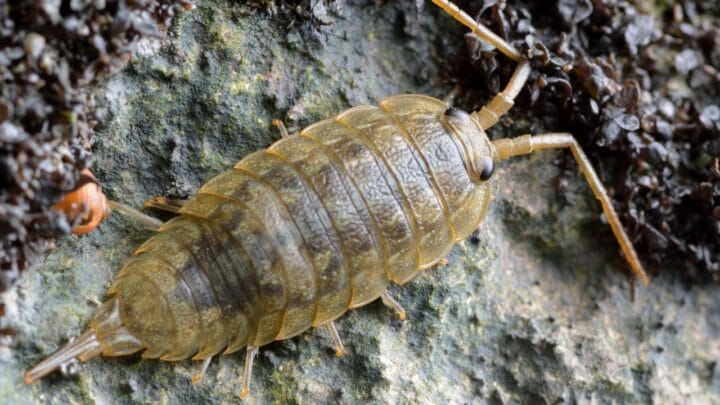When I think of isopods, I think of the tiny tank janitors that live in aquariums and terrariums and munch away at decaying plant matter.
Well, I recently discovered that isopods, also called sow bugs or pill bugs, are actually quite a marvel of design, especially when it comes to how they breathe.
If you’re interested in how these ancient creatures respire, read on to find out more.
How do isopods respire?
Irrespective of species, all isopods have gills that they use to exchange gases and respire. Therefore, they all depend on water. While marine isopods can breathe underwater, however, land isopods will drown if submerged for too long.
How Isopod’s Gills Work
If you were to inspect an isopod through a microscope, you’d notice five distinct abdominal segments on the underside of its body.
Each of these has a pair of branching pleopods, which are thin, plate-like structures that isopods use to breathe.
Also known as gills, pleopods play a vital role in how isopods exchange the necessary gases for breathing. Within each pleopod is a thin, permeable membrane that allows oxygen to enter and exit their systems.
The gills of some terrestrial isopods resemble lungs and have adapted to such a degree that they can survive and breathe through them on land.
For marine isopods, their gills not only help them respire but also provide them with the ability to propel themselves forward in motion.
How Terrestrial Isopods Respire
For terrestrial isopods to thrive, their gills need to stay moist at all times. Their soft underbellies, where their gills are located, are particularly vulnerable to drying out if exposed.
This is the reason why they are most often found living in damp, humid, and dark areas, such as in wood and under bark or rocks.
If isopods are kept away from moisture for extended periods, they will perish. Yet, conversely, they will drown if submerged in water, so finding a balanced environment is paramount for them.
Damp environments provide them with the exact balance of water they require to breathe easily, without overwhelming them. Most often, these types of ecosystems comprise rotting matter with plenty of opportunity for fruitful gaseous exchange into their “lungs.”
Because of how they have adapted to live on land, they cannot breathe underwater.
How Aquatic Isopods Respire
Marine isopods use their gills in much the same way as other sea-dwelling creatures. They take in oxygen from the water, which they use to survive.
That being said, different types of isopods dwell in various bodies of water and have adapted to do so. Some live in freshwater, while others live in shallow ocean pools.
Some even live in deep, deep abysses in the ocean and survive with very little oxygen.
Why Some Isopods Drown in Water Dishes
Many vivarium owners keep isopods in their tanks to clean up after other animals and feed on decaying plant matter.
However, I commonly hear about isopods drowning in the water dishes set out for their tank companions.
The reason for this is two-fold. Isopods love moisture, so it’s natural for them to seek it out, which is usually how they end up in water dishes in the first place.
Secondly, once they are submerged, they will drown if they have nowhere to grip their legs.
A way to combat this is to place some sort of scaffold in your water dish for isopods to climb out on. These can be small stones of a piece of bark.
Observe them and see what works best.
What Isopods Exactly Are
Isopods are tiny, primitive creatures living together with us in this world for hundreds of thousands of years. Some are aquatic, while others have adapted to live on land.
They form part of the crustacean family, although they are much smaller and different from their crab, lobster, and crayfish cousins.
In the natural world, isopods feed on decaying organic matter, making them beneficial to many ecosystems. Hobbyists also culture them as a clean-up crew for different vivariums.
Looks-wise, they are usually elliptical or oval in shape, with antennae on their heads and no less than seven pairs of legs. They have rigid exoskeletons that protect their soft underbodies, and, when threatened, many species curl up tightly to shield themselves from danger.
Of great importance to their physical design is a set of five branching appendages located on their abdomens. These are their gills and what they use to respire.
Frequently Asked Questions about How Isopods Respire
Do isopods drink water?
Isopods do indeed drink water. What’s interesting about them, though, is how they do it. Isopods can drink through their mouthpieces like other insects, but they can also suck up water via a tube-like structure on their rear ends known as a uropod.
How long do isopods live for?
On average, isopods live for about two years. However, some isopod species are known to live for up to five years in ideal conditions.
How do you hydrate isopods?
The best way to hydrate isopods is to ensure they live in a moderated damp and humid environment. They can also gain moisture from food, like fresh fruit and vegetables.
Conclusion
Isopods indeed are evolutionary wonders. In their thousands of years on the planet, they’ve adapted to dozens of different environments while maintaining the same basic breathing structure.
It’s no wonder so many people find these tiny crustaceans so fascinating.


